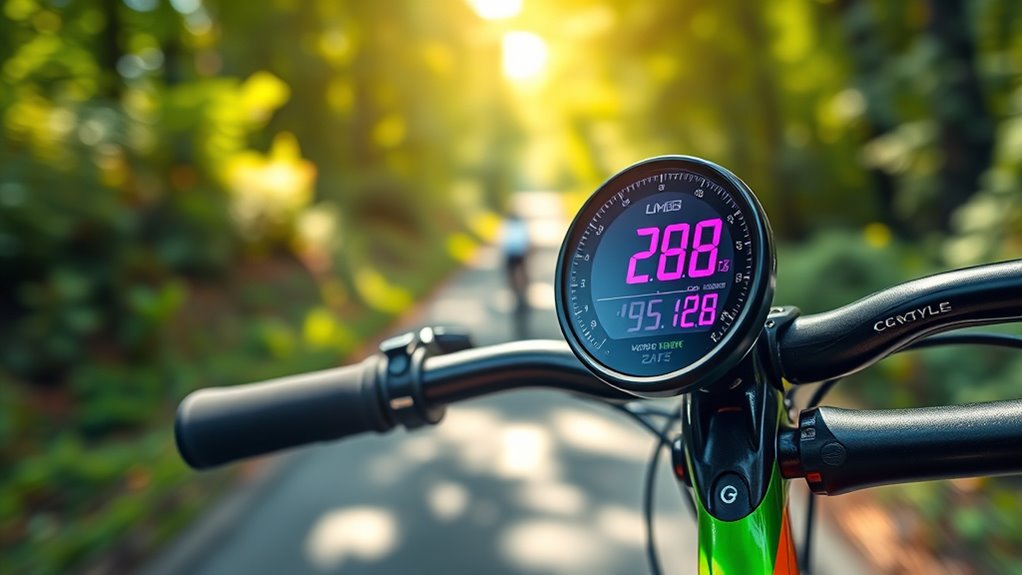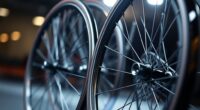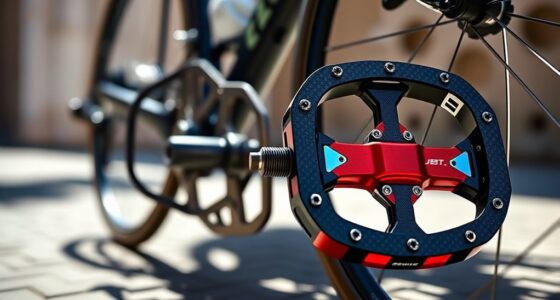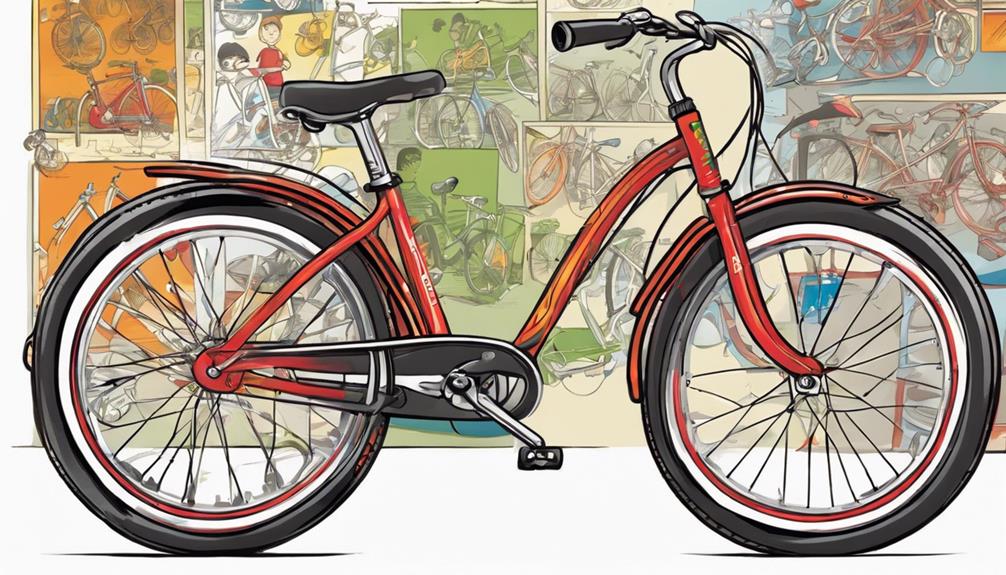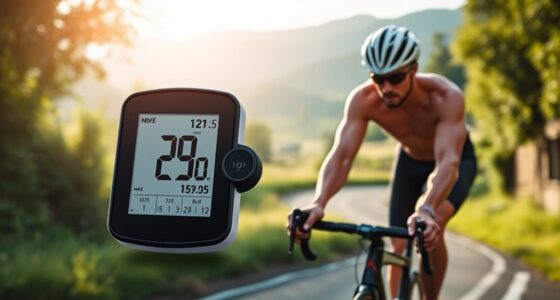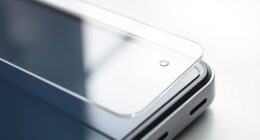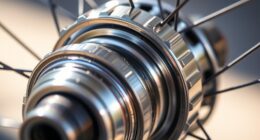If you’re looking for the best bike speedometers of 2025 to track your rides with precision, I’ve done the research for you. Models like the CYCPLUS GPS Bike Computer and the YS SY Wireless Speedometer stand out for their accuracy and features like automatic backlights and waterproof designs. They offer reliable stats to enhance your cycling experience. Stick around, and you’ll discover even more tips on choosing the right speedometer for your needs!
Key Takeaways
- The CYCPLUS GPS Bike Computer offers accurate tracking of speed, distance, and elevation with dynamic GPS positioning and long battery life.
- YS SY Wireless Speedometer is lightweight, easy to install, and features an automatic backlight, but may have occasional accuracy issues.
- CATEYE Urban Wireless Bike Computer is user-friendly with one-button operation and automatic pause tracking, though installation can be tricky.
- Waterproof designs, like the Bicycle Speedometer Waterproof Wireless Cycle Computer, ensure durability in various weather conditions, enhancing reliability during rides.
- Calibration is essential for accurate readings in many models; proper setup, including tire circumference measurement, is crucial for optimal performance.
CYCPLUS GPS Bike Computer, Wireless Cycling Speedometer Odometer
If you’re looking for a reliable bike speedometer that combines advanced technology with ease of use, the CYCPLUS GPS Bike Computer is an excellent choice. It tracks all essential ride data like speed, distance, and elevation with impressive accuracy. I appreciate its automatic backlight, which makes it readable in various lighting conditions. Setting it up took a bit of time, especially adjusting the time zone, but once I got the hang of it, it was smooth sailing. Although it’s slightly bulkier than wired models, its wireless design and long battery life make it easy to use across different bikes.
Best For: Cyclists looking for a reliable and feature-rich bike computer that offers GPS tracking and user-friendly functionality.
Pros:
- Easy-to-read display, even in bright light
- Scratch-resistant glass screen
- Quick signal acquisition after initial setup
Cons:
- Larger size compared to wired units
- May underestimate ride distances in wooded areas
- Vague user manual complicates initial setup
YS SY Wireless Bicycle Speedometer and Odometer
The YS SY Wireless Bicycle Speedometer and Odometer is an excellent choice for cyclists who prioritize simplicity and functionality. Weighing just 90 grams, it’s lightweight and easy to install, making it a great addition to any bike. The LCD display provides clear readings of speed, distance, and riding time, with a handy automatic backlight for night rides. Plus, it features an auto wake-up function that activates upon sensing vibration. While some users report occasional accuracy issues, the overall value for basic cycling needs is solid. Just follow installation instructions closely for the best experience on road or mountain bikes.
Best For: Cyclists looking for a lightweight, easy-to-install speedometer and odometer with essential features for tracking their rides.
Pros:
- Lightweight and compact design makes it easy to add to any bike without adding significant weight.
- Automatic backlight provides clear visibility during night rides, enhancing usability.
- Multi-functionality includes speed, distance, riding time, and temperature readings for comprehensive tracking.
Cons:
- Potential accuracy issues reported by some users, which may affect reliability.
- Wireless signal interference can lead to erratic readings, particularly on certain bike types.
- No on/off switch for battery conservation, which could impact battery life over time.
CYCPLUS GPS Bike Computer, Wireless Cycling Speedometer and Odometer
For cyclists seeking a reliable and user-friendly device, the CYCPLUS GPS Bike Computer stands out with its dynamic GPS positioning and impressive battery life. I love how it tracks ride time, distance, total mileage, and altitude with high accuracy. The automatic backlight is perfect for varying light conditions, and the waterproof design gives me peace of mind. While the setup took a bit of time to adjust, I found it easy to toggle between metrics. Though it’s larger than wired models, the wireless feature makes it convenient for switching bikes. Overall, it’s a fantastic option for any cyclist.
Best For: Cyclists looking for a reliable, user-friendly GPS bike computer that offers accurate tracking and easy portability between bikes.
Pros:
- Easy-to-read display, even in bright light.
- Scratch-resistant glass screen for durability.
- Wireless feature eliminates the need for wheel sensors, simplifying setup.
Cons:
- Larger size compared to wired units may be cumbersome for some users.
- May underestimate ride distances in wooded areas.
- Vague user manual can complicate initial setup for new users.
Bike Computer and Bicycle Odometer Speedometer
Serious cyclists looking for a reliable and feature-rich bike computer will find the Bike Computer and Bicycle Odometer by Hilceriy an excellent choice. It tracks essential metrics like speed, distance, and calories while boasting a waterproof design. I appreciate the LCD display with a backlight for night rides, and the auto wake-up function is a handy feature that saves battery life. While some users mention setup challenges, I found it easy to install. Weighing just 0.08 kg, it’s portable and fits various bike types, making it a solid addition to my cycling gear. Overall, it’s a smart investment for tracking rides.
Best For: Serious cyclists seeking a reliable and feature-rich bike computer to track essential metrics during their rides.
Pros:
- Waterproof design (IPX6) suitable for various bike types.
- LCD display with backlight for visibility in low-light conditions.
- Auto wake-up function that saves battery life and retains previous data.
Cons:
- Some users reported challenges with setup, particularly regarding tire circumference settings.
- Durability issues have been noted with the wire.
- May not be compatible with certain electric-assist bicycles.
CATEYE – Velo 7 Wired Bike Computer
If you’re a beginner cyclist looking for an easy-to-use bike computer, CATEYE’s Velo 7 Wired Bike Computer stands out with its clear, high-contrast display. I love how it shows current, max, and average speed, along with total and trip distances. Installation is simple, though measuring wheel circumference can be tricky. The single-button functionality makes cycling through stats effortless, and it even stops counting time when I’m at a standstill. While I’ve had minor issues with signal, adjusting connections resolved them. Overall, the Velo 7 is a reliable, cost-effective choice for tracking my rides without the hassle of apps.
Best For: Beginner cyclists seeking a straightforward and effective way to track their riding performance.
Pros:
- Easy installation with clear mounting instructions and minimal tools required.
- Large, high-contrast display allows for easy reading of stats while cycling.
- Reliable performance with automatic time tracking that pauses when stationary.
Cons:
- Measuring wheel circumference for accurate data input can be challenging.
- Some users may experience intermittent signal issues due to loose connections.
- Limited functionality compared to more advanced bike computers or smartphone apps.
Bike Computer Speedometer and Odometer DCY016
The Bike Computer Speedometer and Odometer DCY016 stands out for its impressive 16 functions, making it an excellent choice for cyclists who value versatility and reliability. I found its waterproof design and wired setup to be trustworthy, especially when tracking speed and distance. Installation was straightforward, but I had to measure my tire circumference accurately for best results. Some users mentioned challenges with setup, but patience paid off. While it performs well, I noticed slight accuracy issues in wet conditions. Overall, with a 1.5-year warranty and responsive customer service, I believe it’s a solid investment for any cyclist.
Best For: Cyclists seeking a reliable and versatile speedometer and odometer with multiple functions and a waterproof design.
Pros:
- Easy installation with included components and straightforward setup.
- Offers a wide range of functions including speed, distance, and temperature tracking.
- Backed by a 1.5-year warranty and responsive customer service.
Cons:
- Accuracy issues may arise in wet conditions.
- Requires careful measurement of tire circumference for optimal performance.
- Some users reported challenges during initial setup, necessitating patience.
VLOXO Bike Speedometer with Light Set
For cyclists looking for a thorough solution that combines safety and performance, the VLOXO Bike Speedometer with Light Set stands out as a top choice in 2025. This 5-in-1 set includes an impressive 800 lumens front light, a speedometer, a 120 dB bike bell, and a red tail light, making it perfect for any ride. Installation is easy, thanks to video instructions, and the speedometer provides real-time metrics. While the horn is loud and might surprise some pedestrians, the overall value and quality are commendable. Just keep an eye on battery performance, especially at lower charges.
Best For: Cyclists seeking a comprehensive safety and performance solution for various bike types.
Pros:
- Versatile 5-in-1 set includes essential features like a powerful front light, speedometer, and bike bell.
- Easy installation with video instructions makes it user-friendly for all cyclists.
- Waterproof and dustproof design ensures durability in all weather conditions.
Cons:
- Some users have reported glitches with the speedometer and issues with resetting trip data.
- The bike horn’s loudness may startle pedestrians, making it less ideal for quiet trails.
- Battery performance can be inconsistent, particularly when nearing a low charge.
CATEYE – Urban Wireless Bike Computer
Looking for a reliable bike computer that tracks your fitness journey? The CATEYE Urban Wireless Bike Computer has got you covered. It displays current, max, and average speed, along with total and trip distance, elapsed time, and calories burned. I love the one-button operation for easy cycling through options, and it even pauses when I stop at red lights. Installation can be tricky, so I recommend a bike shop for setup. Despite some reports of malfunctions, its lightweight design and accurate readings make it a solid choice for anyone wanting to elevate their biking experience. Don’t wait—get motivated!
Best For: Fitness enthusiasts and casual cyclists looking for an affordable and reliable bike computer to track their performance and motivate their rides.
Pros:
- Lightweight design with comprehensive features for effective fitness tracking.
- One-button operation simplifies use, making it easy to cycle through display options.
- Automatically pauses tracking when stopped, ensuring accurate average speed and elapsed time.
Cons:
- Installation can be tricky, and some users recommend professional setup at a bike shop.
- Reports of malfunctions, particularly with interference from battery-powered lights, affecting speed readings.
- Some users have experienced inaccuracies in measurements, which can diminish overall satisfaction.
Wireless Bike Computer with Multi-Functions and LCD Display
A standout feature of the Wireless Bike Computer is its large 3-inch LCD screen, which makes it incredibly easy to read, whether you’re biking during the day or at night. With 20 multi-functions like distance, speed, and calorie tracking, it covers all your biking needs. I love that it’s wireless, eliminating tangled wires, and the waterproof design means I don’t have to worry about rain. Installation is straightforward, though measuring your wheel circumference is key for accuracy. Overall, this bike computer offers excellent value, giving you features that rival pricier models without breaking the bank.
Best For: Casual and serious cyclists looking for an affordable, feature-rich bike computer that enhances their riding experience.
Pros:
- Large, easy-to-read 3-inch LCD display with backlight for visibility in any lighting.
- Wireless design eliminates tangled wires and enhances convenience.
- Offers 20 multi-functions, covering essential biking metrics like speed, distance, and calorie tracking.
Cons:
- Accuracy relies on proper setup, including measuring wheel circumference and maintaining tire pressure.
- Some users may find installation challenging, especially with handlebar bracket fitting.
- Potential issues with the tire sending unit affecting transmission and functionality, if not secured properly.
Bicycle Speedometer Waterproof Wireless Cycle Computer
Cycling enthusiasts seeking a reliable and easy-to-use device will appreciate the Bicycle Speedometer Waterproof Wireless Cycle Computer. This compact and lightweight unit measures speed, distance, and riding time, making it perfect for fitness lovers like me. Its large LCD display is easy to read, even with the backlight on during night rides. Installation is straightforward, and it fits a variety of bikes, although some electric-assist models might not be compatible. I’ve found it durable enough to withstand rain and rough conditions, plus the battery life is impressive. Just remember to calibrate it for the best accuracy.
Best For: Cycling and fitness enthusiasts looking for a reliable and waterproof speedometer to track their performance.
Pros:
- Lightweight and compact design for easy installation and portability.
- Large LCD display with backlight for visibility in various lighting conditions.
- Durable and waterproof, ensuring functionality in different weather conditions.
Cons:
- Some users may face difficulties with sensor alignment for accurate readings.
- Display brightness may not meet expectations compared to promotional images.
- Compatibility issues with certain electric-assist bicycles.
MakeTheOne Old School Style Bike Speedometer Analog Odometer for Bicycles
For those who appreciate a vintage touch, the MakeTheOne Old School Style Bike Speedometer is an excellent choice for bicycles with wheel sizes between 24″ and 27.5″. It features a stylish chrome bezel and a crystal acrylic face, making it easy to read while you ride. Installation’s a breeze; just mount it on your handlebar, connect it to your front wheel, and you’re set—no batteries required. This mechanical speedometer tracks your speed in kilometers per hour and resets after 9999.9 miles. While it has mixed reviews, it’s a charming addition to any bike enthusiast’s collection.
Best For: Vintage bike enthusiasts looking for a stylish and functional speedometer for their bicycles.
Pros:
- Easy installation with no batteries required, allowing for quick setup.
- Retro aesthetic with a chrome bezel and large readable face.
- Mechanical operation with automatic odometer reset after 9999.9 miles.
Cons:
- Mixed reviews regarding installation ease and durability, with some users facing challenges in securing the device properly.
- Not compatible with certain electric-assist bicycles or quick-release wheels exceeding 38 MPH.
- Measures speed only in kilometers per hour, which may not suit all riders.
ROCKBROS GPS Bike Computer with Mount
Looking for a reliable and budget-friendly option to track your rides? The ROCKBROS GPS Bike Computer with Mount is a solid choice. It accurately tracks your ride time, distance, and altitude, thanks to its support for four satellite navigation systems. The large 2-inch backlit display is easy to read in any lighting. I appreciate its durability; it’s IPX6 waterproof and lasts over 20 hours on a single charge. While installation can be tricky, especially for non-round frames, the customer support is available 24/7 to assist. Overall, it’s perfect for casual cyclists seeking essential metrics without breaking the bank.
Best For: Casual cyclists seeking a budget-friendly option to track essential riding metrics.
Pros:
- Accurate tracking of ride time, distance, and altitude with support for four satellite navigation systems.
- Durable and waterproof design (IPX6) ensures functionality in various weather conditions.
- Long battery life of over 20 hours on a single charge, with automatic sleep mode to conserve energy.
Cons:
- Challenging installation process, especially for non-round bike frames, with potential issues securing the device.
- Unresponsive buttons and unintuitive menus may complicate the user experience, particularly when switching units.
- Lacks advanced features found in higher-priced models, limiting its functionality for serious cyclists.
Bike Speedometer Waterproof Wireless Bicycle Computer
If you want a reliable bike speedometer that can withstand the elements, the Bike Speedometer Waterproof Wireless Bicycle Computer stands out as an excellent choice. It measures speed, distance, and riding time, with a handy clock feature. I love its lightweight design and IP67 waterproof rating, ensuring it holds up in rain. The multi-function LCD display, complete with a night backlight, makes it easy to read anytime. Installation is straightforward, though the initial setup requires precise input for tire circumference. Overall, it delivers accurate readings and durability, making it a solid companion for all my biking adventures.
Best For: Cyclists who need a durable and reliable speedometer that performs well in various weather conditions.
Pros:
- Lightweight and waterproof design ensures durability during rides in rain or adverse weather.
- Multi-function LCD display with a night backlight provides clear visibility in low light conditions.
- Accurate speed and distance tracking after proper setup, making it a dependable companion for biking adventures.
Cons:
- Initial setup can be challenging, requiring precise input for tire circumference.
- Occasional interference from handlebar-mounted lights may affect readings.
- Users may need to reprogram the device after battery replacement, which can be cumbersome.
Bike Computer and Bicycle Odometer Speedometer
The DonDofla Bike Computer stands out for its impressive 3.3-inch large screen, making it an ideal choice for serious cyclists who value clear data visibility on rugged terrain. With features like speed tracking, distance, calories burned, and temperature, it offers a thorough overview of my ride. The waterproof design is a bonus, and the day and night backlight guarantees I can read it in any condition. Installation is straightforward, and I love the wireless functionality. Though some users mention the setup can be tricky, once I figured it out, it became an invaluable tool for tracking my cycling goals.
Best For: Serious cyclists who want a reliable and feature-rich bike computer for tracking their performance on various terrains.
Pros:
- Large 3.3-inch screen for clear visibility in all riding conditions.
- Multi-functional capabilities including speed tracking, distance, calories, and temperature.
- Waterproof design and wireless functionality for ease of use and installation.
Cons:
- Some users find the setup process complicated and difficult to navigate.
- Instructions for installation may lack clarity, leading to confusion.
- Additional rubber pads may be needed to prevent vibrations during rides.
Bike Computer with LCD Display and Waterproof Design
For cyclists seeking reliability in all weather conditions, the waterproof design of the Hicvers Bike Computer makes it an excellent choice. This versatile device features a large LCD display, ensuring I can easily read my stats, even during rain. It measures traveling speed, maximum speed, average speed, mileage, and time, all at my fingertips. Installation’s a breeze with its simple two-button interface. While it’s compatible with various bike types, I’ve noticed mixed reviews about connection consistency. Still, its IP54 rating gives me peace of mind when riding through unpredictable weather. Overall, it’s a solid option for dedicated cyclists.
Best For: Cyclists looking for a reliable and waterproof bike computer to track their performance in varying weather conditions.
Pros:
- Multi-functional with the ability to measure speed, mileage, and time.
- Easy installation with a user-friendly two-button interface.
- Waterproof design rated IP54, ensuring functionality in rainy conditions.
Cons:
- Mixed reviews on connection consistency and reliability.
- Some users find programming and setup difficult.
- Average customer ratings suggest room for improvement in user experience.
Factors to Consider When Choosing Bike Speedometers
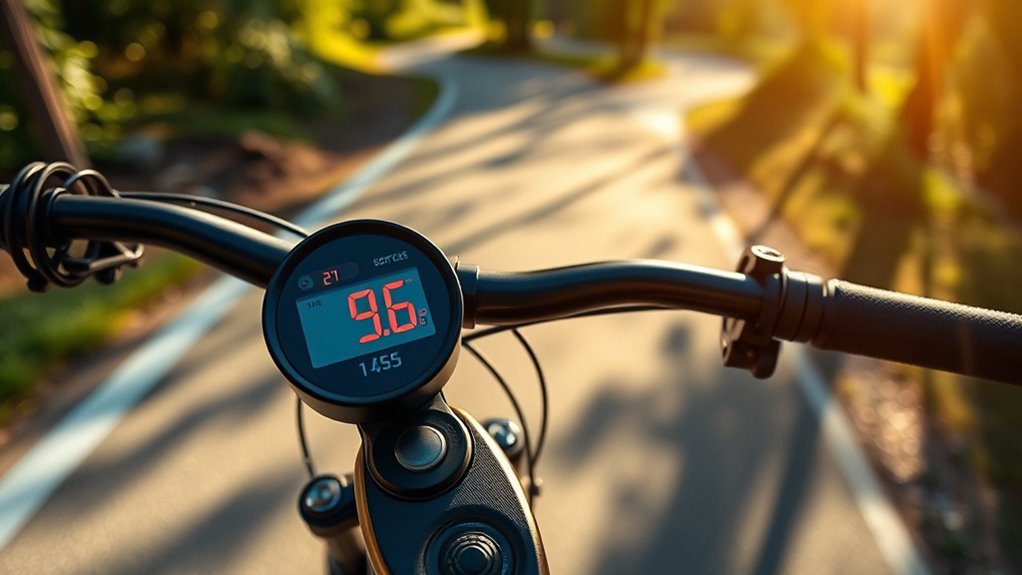
When choosing a bike speedometer, I think it’s vital to take into account factors like display size, whether you want a wireless or wired option, and waterproof ratings. Battery life is another important aspect that can’t be overlooked, along with how easy it is to install. Each of these points can greatly affect your riding experience.
Display Size and Type
Choosing the right display size and type for a bike speedometer can considerably enhance your riding experience. I’ve found that larger screens are generally easier to read, especially for those of us with visual impairments. LCD displays are great because they offer clear contrast in various lighting conditions, and opting for a backlit option can make a big difference during night rides. I appreciate models that show multiple metrics, like speed, distance, and time, allowing me to monitor my performance without breaking my focus. Plus, some speedometers come with automatic backlight activation, which is fantastic for shaded areas. Ultimately, I prefer displays that let me cycle through statistics seamlessly, keeping my ride smooth and enjoyable.
Wireless vs. Wired
While both wireless and wired bike speedometers have their advantages, the choice often comes down to personal preference and riding style. I appreciate the convenience of wireless models, as they eliminate the clutter of wires and make installation a breeze. However, I can’t ignore the reliability of wired speedometers. Their direct connection means fewer issues with signal interference, especially on longer rides. I’ve noticed that wireless models can also have varying battery life, sometimes requiring frequent replacements, while wired options last for years without battery worries. In addition, in harsh weather, wired speedometers hold up better, as their connections are less affected by rain or other environmental factors. Ultimately, it’s about what fits your riding habits best.
Waterproof Ratings
Having considered the pros and cons of wireless and wired speedometers, it’s time to address another essential factor: waterproof ratings. When choosing a bike speedometer, I always check the Ingress Protection (IP) code. For example, IPX6 protects against splashes, while IPX7 withstands submersion up to 1 meter. A higher rating means my speedometer will perform reliably in heavy rain, minimizing the risk of water damage. If I plan to ride in various weather conditions, I look for models rated IP54 or higher. Additionally, I pay attention to the construction materials and sealing, as these features enhance durability. Just remember, prolonged exposure or submersion might exceed a speedometer’s capabilities, leading to potential malfunctions.
Battery Life Considerations
When it comes to bike speedometers, battery life can make a significant difference in your riding experience. I’ve seen models with rechargeable batteries lasting over 50 hours, which is fantastic for long rides. In contrast, some speedometers only last a few months before needing a replacement. I prefer those that use lithium batteries; they perform better in extreme temperatures and generally last longer than alkaline ones. Look for features like auto sleep modes, which conserve battery life during inactivity. Having a battery life indicator is also a lifesaver, letting me know when it’s time to recharge or replace. Finally, consider environmental factors—devices with higher IP ratings are better protected against moisture and humidity, which can affect battery performance.
Installation Ease
Battery life isn’t the only factor that can impact your experience with bike speedometers; installation ease plays a significant role too. I’ve found that the setup process varies greatly among different models. Some units offer a straightforward installation requiring just mounting components and sensor adjustments, while others can get pretty complicated. Wireless bike computers are often easier to install since they eliminate wires, but you’ll need to ascertain proper sensor alignment for accurate readings. I’ve also noticed that the quality of installation instructions can vary—some manuals are clear, while others leave you scratching your head. Don’t forget to take into account the mounting bracket design and be prepared to calibrate your speedometer by measuring tire circumference.
Compatibility With Bike Types
Choosing the right bike speedometer can feel overwhelming, especially with the variety of bike types out there. It’s essential to guarantee the speedometer is compatible with your specific bike, whether it’s a road bike, mountain bike, or folding bike. Keep in mind that some models might not work with electric-assist bikes.
Also, pay attention to the installation process; many wireless speedometers require precise sensor placement that can vary based on your bike’s design. Don’t forget to check if the speedometer accommodates your tire size for accurate readings. Finally, consider compatibility with your bike accessories, like battery-powered lights, which can interfere with performance. These factors will help you choose the best speedometer for your ride.
Range of Functions
While browsing bike speedometers, it’s important to take into account the range of functions they offer. I find that models measuring current, average, and maximum speed, along with distance traveled and riding time, are fundamental. For serious cyclists, GPS functionality can track routes, altitude, and total mileage, making each ride more enriching. I also appreciate features like auto wake-up, which activates the device when I start moving, and backlighting for those dim evening rides. It’s vital to confirm compatibility with my bike type, especially if I ride an electric-assist model. Finally, I prefer speedometers that are easy to install and have intuitive controls, as they enhance my overall cycling experience and guarantee accurate performance tracking.
Frequently Asked Questions
How Do I Calibrate My Bike Speedometer?
Calibrating my bike speedometer is pretty straightforward. First, I measure a known distance, like a mile or kilometer. Then, I ride that distance and note the speedometer reading. If it’s off, I adjust the settings according to the manufacturer’s instructions. I usually input the correct wheel size or use a calibration function if my speedometer has one. After a few test rides, I make sure it’s accurate for future rides!
Can I Use a Bike Speedometer for Indoor Cycling?
I always thought a bike speedometer was only for outdoor adventures, but guess what? I’ve found they’re perfect for indoor cycling too! You can absolutely use a bike speedometer on a stationary bike. Just attach the sensor correctly, and it’ll track your speed and distance like a pro. It’s like bringing the thrill of the open road indoors! So, if you’ve got one lying around, give it a go during your next workout!
What Is the Battery Life of These Speedometers?
When I look for bike speedometers, battery life is always a top priority. Most models I’ve encountered typically boast a battery life ranging from several months to a couple of years, depending on usage. I’ve noticed that wireless models tend to drain batteries faster than wired ones. It’s crucial to check the specifications for each model, so I make sure to choose one that suits my riding habits and won’t leave me stranded mid-ride.
Are Bike Speedometers Compatible With Electric Bikes?
I’ve found that most bike speedometers are compatible with electric bikes, but it’s good to double-check specifications before buying. Some models may have features tailored for traditional bikes, while others are designed to handle the unique aspects of e-bikes. I recommend looking for speedometers that specifically mention compatibility with electric bikes to guarantee accurate readings. It’s always worth doing a little research to find the best fit for your ride!
How Do I Mount a Speedometer on My Bike?
Mounting a speedometer on my bike is pretty straightforward. I usually start by choosing a spot on the handlebars or the front fork that’s easy to see. I attach the sensor to the wheel or frame, ensuring it aligns with the magnet on the spokes. Finally, I secure the display unit, make sure everything’s tight, and double-check the alignment. It only takes a few minutes, and I’m ready to track my rides!
Conclusion
To sum up, choosing the right bike speedometer can truly transform your riding experience, making it feel like you’re flying through the air with the precision of a fighter jet! Whether you’re a casual rider or a serious cyclist, investing in a quality speedometer will help you track your performance and push your limits. So, gear up, pick the perfect device, and let every ride be an adventure that propels you toward your cycling goals!
